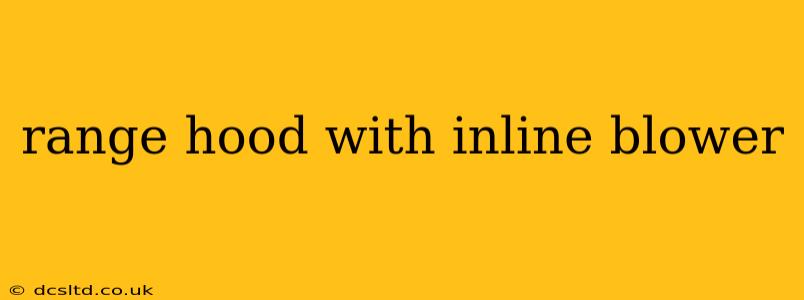Are you renovating your kitchen and considering a range hood with an inline blower? This comprehensive guide will walk you through everything you need to know about these powerful and versatile ventilation systems. We'll cover the benefits, drawbacks, installation considerations, and help you choose the perfect inline blower range hood for your needs.
What is a Range Hood with an Inline Blower?
Unlike traditional range hoods with built-in blowers, a range hood with an inline blower separates the fan motor from the hood itself. The motor is housed in a separate unit, typically located in a cabinet, attic, or even outside the house. A duct connects the hood to the inline blower, which then vents the air outside.
Why Choose a Range Hood with an Inline Blower?
There are several compelling reasons to opt for a range hood with an inline blower:
-
Quieter Operation: Because the motor is located away from the kitchen, these hoods are significantly quieter than those with built-in blowers. The noise is minimized, creating a more peaceful cooking environment.
-
Increased Power and Efficiency: Inline blowers often offer higher CFM (cubic feet per minute) ratings, meaning they can remove more air from your kitchen faster and more effectively. This is particularly beneficial for larger kitchens or those with powerful cooking appliances.
-
More Design Flexibility: The separation of the motor allows for more flexibility in hood design. You're not limited by the space required for a bulky motor inside the hood itself, opening up options for sleeker, more modern designs.
-
Easier Installation in Certain Situations: In some situations, an inline blower might be easier to install than a traditional under-cabinet hood, especially if the location of the existing ductwork is not ideal.
How Does an Inline Blower Range Hood Work?
The process is straightforward: cooking fumes and smoke are drawn up through the hood and into the ductwork. This air then travels to the inline blower, where the fan pushes it outside. The external venting is crucial for effectively removing odors and pollutants from the kitchen.
What are the Disadvantages of Inline Blower Range Hoods?
While inline blower range hoods offer numerous advantages, there are some drawbacks to consider:
-
Installation Complexity: Installing an inline blower system can be more complex than installing a traditional range hood, often requiring professional help. You'll need to plan for ductwork routing and the location of the inline blower unit.
-
Higher Initial Cost: Generally, inline blower systems are more expensive than comparable range hoods with built-in blowers due to the added components and installation complexity.
-
Potential for Noise from Ductwork: While the blower itself is typically quieter, improper installation or poorly designed ductwork can lead to noise issues.
-
Maintenance Challenges: Accessing the inline blower for maintenance might require dismantling parts of your kitchen cabinetry or accessing the attic or exterior of your home.
What CFM Rating Do I Need?
The appropriate CFM (cubic feet per minute) rating depends on the size of your kitchen and the power of your cooking appliances. Larger kitchens and gas cooktops typically require higher CFM ratings. Consult your local building codes and consider professional guidance to determine the correct CFM rating for your needs.
How Much Does a Range Hood with an Inline Blower Cost?
The cost varies greatly depending on the brand, features, size, and CFM rating. Expect to pay significantly more than a comparable range hood with a built-in blower, ranging from several hundred to several thousand dollars.
Where Should the Inline Blower Be Located?
The best location for the inline blower unit depends on your home's construction and layout. Common locations include:
-
Within a cabinet: This is a convenient option if you have sufficient space within your kitchen cabinetry.
-
In the attic: This is a viable choice, but ensuring proper ventilation and access for maintenance are critical.
-
Outside the house: This option can be noisy if not properly insulated and requires exterior venting.
Can I Install an Inline Blower Range Hood Myself?
While some DIY-inclined homeowners may attempt installation, it's often recommended to hire a professional. Proper installation is crucial for optimal performance, safety, and to avoid potential noise issues or future problems.
This guide provides a comprehensive overview of range hoods with inline blowers. Remember to carefully consider your kitchen's layout, cooking habits, budget, and the level of expertise you have before making a decision. Investing in a high-quality system from a reputable manufacturer will ensure years of efficient and quiet kitchen ventilation.
